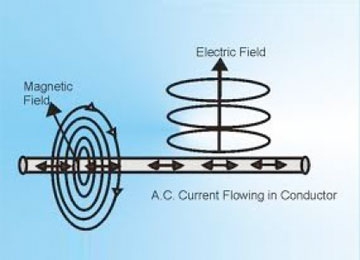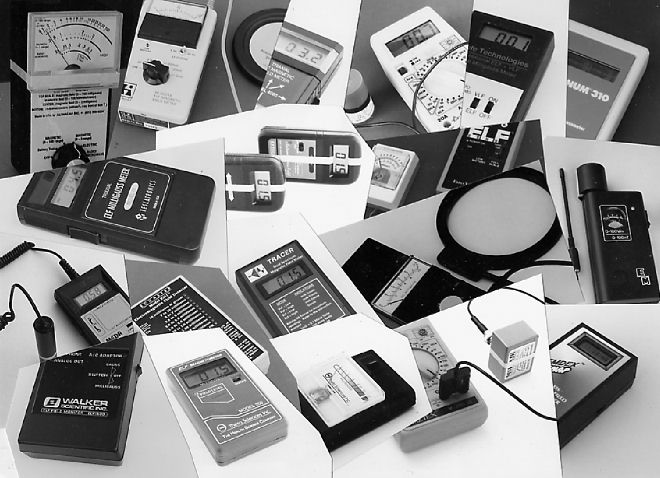|
Sources of electromagnetic
radiation are everywhere...
Power lines, appliances, TV sets, computers, cell
phones, you name it. All electrically powered devices generate electromagnetic
waves. Many household devices emit electromagnetic radiation even when they’re
turned off.
In addition to the
countless sources of manmade electromagnetic radiation, the earth and its
atmosphere are seething with natural electromagnetic activity. The sun plays a
big role in our natural electromagnetic environment, while the stars and even
the planet Jupiter also factor in, to a lesser but detectable degree.
| The acronym “EMF” has
become a well-known abbreviation for “electromagnetic field”.*
These terms can refer to
electromagnetic fields emanating from a
specific source, or to the combined level of electromagnetic radiation being
produced by all sources within range at a certain location and time.
The graphic at right illustrates the
two components of EMF, namely the electric field and the magnetic
field, which radiate from a current-carrying conductor at right angles to
the current flow, and to each other. |
 |
|
*In the early days of electrical
discovery, E.M.F. referred to "electromotive force", i.e., the force that
is measured in volts. These terms are a bit outdated now, but many scientists still use
them in the original context. Using EMF to mean "electromagnetic field" is more of a
popular expression rather than a formal scientific term, but it has
certainly become well-established in our culture. |
Public interest in
EMF’s has risen tremendously in recent years for two rather diverse reasons:
1)
There's been a great deal of
controversy about the effects of EMF’s on human health. Specifically, people are
concerned
that exposure to EMF’s may be related to cancer, leukemia, Alzheimer’s disease,
and other disorders associated with pathological cell growth. "Officially" there
is no verifiable connection as of yet, but even the skeptics advise caution
and prudent avoidance.
2)
There has also been lots of
speculation linking EMF’s to paranormal activity...
One school of thought says
that EMF’s can stimulate abnormal brainwave activity and create false
sensations of experiencing a paranormal event – a ghostly encounter, or an alien
abduction, that sort of thing. Dr. Michael Persinger is well known for his
"brain-helmet" experiments that demonstrate the strange ways in which
electromagnetic stimulation can affect our perception and cognitive processes.
On the other hand, many
investigators believe that paranormal activity is real and suspect it may be
triggered by high EMF’s. Also, evidence from a multitude of case studies
suggests that paranormal events are often accompanied by unusual electromagnetic effects of
their own.
Thanks to the ongoing
interest in EMF's from both professional and amateur investigators,
EMF meters have become
a popular tool for measuring electromagnetic fields. These meters are usually
calibrated in terms of gauss (G) or milligauss (mG). The earth’s slowly
fluctuating magnetic field averages about 500mG, while the background EMF of a
typical home measures about 1-2 mG above the earth’s field. A few EMF meters
are calibrated in terms of teslas (T) with 1 tesla equal to 10,000 gauss.
EMF meters are available
in a variety of styles and with a wide range of prices, but they all do one
thing:
EMF meters display a numerical value that
represents
the relative strength of the local electromagnetic field.
|
Some meters use the
familiar moving needle pointer, some give a digital readout, others have a
graphical display with multi-colored lights.
Some are designed to look scientific and technical, others have pictures of cute little ghosts or UFO’s
printed on them.
Regardless of their design,
optional features, and marketing
claims, all EMF meters do the same thing: they indicate the relative strength of
the local electromagnetic field.
|
 |
In other words, EMF meters
measure a “quantity”. They give us a number, but they don’t tell us anything
about the “quality” of what it is they’re measuring...
As far as a meter is
concerned, the EMF generated by a lamp is the same as the EMF generated
by a computer which is the same as the EMF generated by a television set, etc.
Unfortunately, that’s a gross oversimplification.
There are many distinctive
differences in the qualities of electromagnetic radiation generated by different sources. These
qualities include such variables as frequency,
polarity, waveform, pulse duration, etc. EMF meters are blind to these
differences; they measure everything in terms of quantity
and then display a number on an arbitrary scale.
|
Imagine walking
into a grocery store and telling
the clerk you’d like to buy two pounds.
"Two pounds of what?"
she’d probably ask.
You just look back at
her blankly and
say,
"Two pounds please."
Of course, everyone
knows there are differences
between a pound of flour, a pound of beef, and
a pound of caviar – or apples and oranges.
We understand that these are distinctly different
commodities and that each has its own unique
characteristics and value that go beyond what
a number on a scale can tell us.
|
 |
We wouldn’t think of
lumping everything together at the check out register and expect to pay
for a two pound mix of assorted groceries, but that’s very similar to what we’re
doing when we use an EMF meter to evaluate our electromagnetic environment. It
really doesn't make much sense.
The problem is that we’ve
never seen, felt, tasted, smelled, or heard electromagnetic waves. We don’t have
that first-hand sense of familiarity with them, so it isn’t intuitively obvious
that there might be significant differences between the electromagnetic fields produced by
different sources. Put simply, we don't even know what we don't know.
That's
where the Wave Wizard comes in...
Think of the Wave Wizard as a special
kind of radio. It's not for listening to music or chat, it's for
listening directly to electromagnetic waves. As soon as you start hearing EMF's
through the Wave Wizard, you will begin to develop a better sense of what's
really going on in the electromagnetic world around you.
Technically speaking, the Wave Wizard is
a type of transducer
– a device that converts one form of energy into another.
A microphone is a transducer that converts sound waves into an
electrical signal. The Wave Wizard works the other way around, it converts
electromagnetic energy into sound waves that you can listen to in real time
through standard earphones.
The Wave Wizard is open to a broad range
of frequencies all at once, meaning that you can hear the EMF sounds coming
from any number of sources simultaneously. The sounds that you will hear correspond
exactly to the frequency and waveform characteristics of the electromagnetic
fields emanating from those sources.
When using the Wave Wizard, you will be
able to hear and distinguish subtle (and not so subtle) differences between the
various forms of EMF, and you can learn to recognize certain signature
characteristics
– just as you're able
to hear and distinguish different instruments playing in an orchestra.
What you will be hearing with the Wave Wizard is more like a "cacophony" than a
symphony though. Some of the sounds will seem harsh and grating, others will be
evanescent whirs, whines, crackles, chirps, and pops. Always changing, often
fascinating, sometimes a little frightening.
And remember, you can hear sounds emanating not just from manmade electrical equipment, but from
natural electromagnetic sources
as well. So...
Could any of these
sounds be coming from sources that are supernatural?
The Wave Wizard has been
used extensively during investigations of sites with suspected paranormal activity. The device repeatedly led to breakthrough discoveries that
could not have been made using any other method. Based on these observations,
several specific theories (not just abstract speculations) concerning the
electromagnetic wave nature of "ghosts" and "poltergeist" have been put forth.
There will be much more
about all of this, as well as details about a Wave Wizard user who may have been
the first person to ever hear the direct electromagnetic signal from a ghost, in
the user's manual. For now, suffice it to say that the Wave Wizard has already
proven itself to be the most promising and scientifically useful tool that the
paranormal research community has seen in decades.
|

Konstantin Raudive with
the Goniometer.
|
One important benefit for paranormal researchers
is that some of the things you can hear with the Wave Wizard are exactly the
kinds of things that can create false signals when you're trying to record EVP's.
All
recording equipment is subject to spurious interference
from electromagnetic radiation. Such interference can produce audible effects that
might be mistaken for mysterious voices in a recording.
By using the Wave Wizard to monitor
ambient EMF's during recording sessions, you can be alerted to normal
electromagnetic effects and avoid confusing them with anything paranormal.
In fact, the Wave Wizard itself can be
used in conjunction with a recorder to provide a method for EVP
experimentation that bears some similarities with Raudive's 1950's era
Goniometer.
If the unseen forces that produce EVP's
are indeed electromagnetic in nature, then the Wave Wizard should make an ideal
interface for capturing them on tape or digital media.
|
If your interest in studying EMF's
runs more in terms of their effects on living organisms,
then the Wave Wizard can open the door
to a whole new universe of research possibilities. Until now, all of the studies
that have been done in this regard have taken the "lump it all together"
approach by using EMF meters to quantify the level of electromagnetism that
people (or lab animals) have been exposed to.
Once again, the truth is that not all
EMF's are the same, and it could be that by overlooking this simple fact,
scientists are missing their opportunity to identify which specific aspects of
EMF may be hazardous to human health.
*
* *
* *
Regardless of the reasons behind your interest in electromagnetic fields, the
important thing to understand is that the Wave Wizard can open your ears and
your mind to something that very few people have ever experienced or even heard
about. The possibilities for ground-breaking research are limited only by your
imagination and your pioneering spirit.
The Wave Wizard costs about the same
as a good quality EMF meter, but it delivers so much more.
It is simple to use right out of the
box, you don't have to be a techno-geek to figure it out, and the user's manual
will provide lots of helpful advice, suggestions, and additional background
information on what to listen for as you begin to explore the fascinating world
of EMF's.
Please
contact me for more information.
|